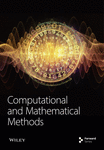Parameter-Uniform Convergent Numerical Approach for Time-Fractional Singularly Perturbed Partial Differential Equations With Large Time Delay
Abstract
In this study, we consider a parameter-uniform convergent numerical approach for a class of time-fractional singularly perturbed partial differential equations (TF-SPDPDEs) with large delay in time that exhibits a regular exponential boundary layer on the right side of the spatial domain. An arbitrary very small parameter ε(0 < ε < <1) multiplies the highest-order derivative term of these singularly perturbed problems. The time-fractional derivative is considered in the Caputo sense with order α ∈ (0, 1). The numerical scheme comprises the L1 scheme and nonstandard finite difference method (FDM) for discretizing the time and space variables, respectively, on a uniform mesh. To show the parameter uniform convergence of the proposed method, the truncation error and stability analysis are discussed. The method is shown to be parameter-uniform convergent of order O((Δt)2−α + Δx), where Δt and Δx are the step sizes in the time and space directions, respectively. In order to confirm the theoretical predictions, two numerical examples are presented, and the numerical results support the theoretical concepts discussed. Finally, to show the advantage of the proposed scheme, we made comparisons with the existing numerical methods in the literature, and the numerical results reveal that the present scheme is more accurate.
1. Introduction
In different fields of science and engineering, we frequently encounter partial differential equations (PDEs) whose solutions have a multiscale property. This means that in some regions of the domain, the solution behaves smoothly and abruptly in other regions. PDEs that have this property are said to be singularly perturbed PDEs (SPPDEs). The regions where the solution changes abruptly are the inner and/or boundary layer regions, and the parts of the domain where the solution behaves smoothly are the outer regions. If such a rapid change occurs at the boundary of the domain, then the phenomenon is said to be a boundary layer phenomenon. Mathematically, the PDE is singularly perturbed when the perturbation parameter (ε) multiplies the highest-order derivative. This leads to the solution of the SPPDE being qualitatively different from the solution of the unperturbed problem when we set ε = 0. SPPDEs are applicable in various branches of science and engineering, such as in fluid dynamics, quantum mechanics, chemical reactor theory, elasticity, and the theory of porous gas electrodes [1].
Due to the influence of the perturbation parameter, standard numerical methods, such as the finite difference method (FDM), finite element method (FEM), finite volume method (FVM), and collocation method, fail to solve SPPDEs, and unacceptably large oscillations occur in the boundary layer region, unless the mesh discretization used is extremely fine, which is computationally expensive and not practical. To avoid this problem, one needs to use parameter-uniform convergent numerical methods to solve SPPDEs. In the literature, there are two popular uniformly convergent numerical methods for solving SPPDEs in the context of FDMs [2]. They are fitted operator method (FOM) and fitted mesh method (FMM). FOM controls the rapid (abrupt) change of the solution in the boundary layer region by introducing a fitting factor or denominator function on the term containing the singular perturbation parameter with a uniform mesh, whereas FMM uses fine meshes in the boundary layer region and coarse meshes in the region away from the boundary layer (outer region). FMMs are defined on piecewise uniform meshes. FOM can be divided into two groups: the exponentially fitted operator FDM (EFOFDM) and the nonstandard FDM (NSFDM). NSFDM controls the rapid growth of the solution of SPPDEs in the boundary layer region by replacing the denominator of the classical second-order central finite difference approximation of the second-order derivative with a positive function constructed systematically using Mickens rules [3].
In recent decades, fractional calculus has gained great emphasis due to its wide applications in many areas of science and engineering, such as in fluid flow problems with a porous medium, anomalous transport in cell biology, oil industry, neural networks, mass transfer in fluids, feedback control system, finance, and viscoelasticity material [4–8]. It is the study of arbitrary-order derivatives and integrals. Since fractional-order derivative and integral operators have nonlocal characteristics, it is confirmed that they can accurately model the memory effect and the hereditary properties of certain complex systems with anomalous dynamics [9], which are neglected in integer-order derivative and integral operators. There are different definitions of fractional derivatives such as Riemann–Liouville, Riesz, Caputo, Grunwald–Letnikov, Marchaud, Weyl, and Sonin–Letnikov. In this paper, we used the Caputo fractional derivative because it allows the traditional initial and boundary conditions with a known physical interpretation. The PDEs that contain fractional-order derivatives are classified into two groups [10]. They are space-fractional PDEs (SF-PDEs) and time-fractional PDEs (TF-PDEs). Specifically, a TF-PDE can be used to model the time-related anomalous dynamics, which is widely used in oil reservoir simulations, transport of mass and energy dispersion of chemicals in reactors, and so on [11].
In contrast to classical PDEs, which model physical problems only at the current instant, delay PDEs (DPDEs) and time-fractional DPDEs (TF-DPDEs) are used to simulate physical problems for which the future state depends on both the present state and the past history of the system. They give more realistic models for many problems in science and engineering. For this reason, one cannot neglect the delay term, despite the whole history being considered by time-fractional differential equations [10]. Moreover, TF-DPDEs that contain a perturbation parameter are said to be time-fractional singularly perturbed DPDEs (TF-SPDPDEs). Due to the nonlocal property of the time-fractional derivative and the involvements of the perturbation and delay parameters, it is very difficult to find the exact solutions of TF-SPDPDEs. Therefore, we need to find at least an approximate solution using a numerical method that converges uniformly with respect to the perturbation parameter ε.
During the past few decades, various semianalytical methods have been used, such as the Laplace transform method [12], Fourier transform method [13], Adomian decomposition method [14], homotopy perturbation method [15], variational iteration method [16], and generalized differential transform method [17], and numerical methods such as the FDM [18–20], FEM [21], operational matrix method [22], and collocation method [23] have been introduced to solve FPDEs. For instance, Choudhary, Singh, and Kumar [10] proposed a numerical method for a class of TF-PDEs with delay in time. The numerical method comprises the Crank–Nicolson method for the uniformly discretized time domain and the Spline method with a tension factor in the spatial domain. Rihan [24] presented θ-method to solve linear and nonlinear TF-DPDEs. However, the problems considered in the above work are not singularly perturbed. Relatively, if the problems are not singularly perturbed (in the absence of the perturbation parameter), we may not have numerical difficulties to solve.
Within the past 20 years, many scholars have been studied on numerical treatment of classical (integer-order) singularly perturbed DPDEs (e.g., see [25–34] and the references therein). However, the numerical treatments of the TF-SPDPDEs are still at the initial stage. The scholars Sahoo and Gupta in [35] designed a parameter uniformly convergent numerical scheme for a class of time-fractional singularly perturbed convection–diffusion problems without a delay term that exhibits a weak initial layer at the initial time t = 0 and an exponential boundary layer on the right side of the spatial domain as ε⟶0. They discretized the time-fractional derivative using a classical L1 scheme on a graded mesh and a piecewise uniform Shishkin mesh to the space derivatives. Similarly, these authors in [36] developed a robust higher-order uniformly convergent numerical scheme to solve the same problem. The authors employed Alikhanovs L2 − 1σ approximation in the temporal direction on a graded mesh, and the space domain is discretized on a piecewise uniform Shishkin mesh using a combination of midpoint upwind and central finite difference operators. Liu et al. [11] designed a stable numerical scheme to solve time-fractional SPPDEs with variable coefficients. They employed the tailored finite-point method to approximate the space derivative and the Grunwald–Letnikov and L1 schemes to approximate the time-fractional derivative. Kumie, Tiruneh, and Derese in [37] employed the Crank–Nicolson method combined with the NSFDM for solving TF-SPDPDEs. The authors Aniley and Duressa in [38] presented the NSFDM to solve the time-fractional singularly perturbed convection–diffusion problems with a delay in time. The time-fractional and space derivatives are discretized by using the Crank–Nicolson and NSFDMs, respectively, on a uniform mesh. The scholars Kumar, Podila, and Vigo-Aguiar in [39] developed a parameter uniformly convergent numerical scheme to obtain an approximate solution of time-fractional SPPDEs with delay in time. They used the L1 scheme on a uniform mesh to approximate the time-fractional derivative and the stable FDM with piecewise uniform meshes (which are adequate for FMMs) to approximate the spatial derivatives. Motivated by the study of Kumar, Podila, and Vigo-Aguiar in [39], in this work, this study is aimed at designing a parameter uniformly convergent numerical method with a better accuracy to solve the time-fractional SPPDEs with a large delay in time, which is given in Equations (1) and (2). To approximate the time-fractional and space derivatives, we employed the L1 scheme and NSFDM, respectively, on a uniform mesh. NSFDM, which is one of the FOMs, has an advantage over FMM that is easy to implement and does not require any priori information about the location and width of the boundary layer(s) [40]. The advantage of the proposed method is to develop more accurate parameter uniformly convergent numerical scheme to solve time-fractional SPPDEs with large time delay.
The remaining parts of the paper are structured as follows: Problem formulation appears in Section 2. Section 3 describes the numerical discretization of the continuous problem. In Section 4, we show the convergence analysis of the fully discrete scheme. Numerical examples and results are presented in Section 5, which validates the theoretical results. The article ends with Section 6, which is devoted to the conclusion.
2. Formulation of the Continuous Problem
Under these assumptions imposed on the functions ψb(x, t), ψl(t), ψr(t), and f at the corners of Ω, the interval boundary value problem (Equations (1) and (2)) admits a unique solution u(x, t) that exhibits a regular exponential boundary layer of width O(ε) at x = 1 of Ω, when the perturbation parameter becomes very small (ε⟶0). Because of the nonlocality (long memory) of the fractional-order derivative and the model problem contains the delay and perturbation parameters, it is a difficult task to solve singularly perturbed TF-PDEs effectively and accurately. Hence, designing simple and more accurate ε-uniform convergent numerical methods (i.e., methods whose accuracy does not depend on the perturbation parameter) for such problems is an important task and is the objective of this study.
2.1. Properties of the Continuous Problem
In this subsection, we describe some properties of the continuous problem given in Equations (1) and (2) that ensure the applicability of the maximum principle for the stability estimate of its analytical solution. These properties are essential for analyzing the numerical schemes of the semi- and fully discrete problems, which we will present in the next sections.
Lemma 1 (continuous maximum principle). Let satisfy Φ(x, t) ≥ 0, ∀(x, t) ∈ Γ and . Then, .
Proof 1. The proof of this lemma can be done by contradiction. Suppose such that
Lemma 2. The solution of the continuous problem given in Equations (1) and (2) satisfies the following estimate:
Proof 2. Using the smoothness and compatibility conditions of the solution of the continuous problem (Equation (1)) at the corner points (i.e., (0,0) and (1,0)) and the continuous maximum principle given in Lemma 1 on the barrier functions defined by
On the boundary Γb,
Additionally, for (x, t) ∈ Ω,
Thus, by using the continuous maximum principle given in Lemma 1, we obtain
This implies that
Proof 3. For every , we have the following:
Since |ψb(x, 0)| is bounded and using Lemma 2, we obtain the desired result.
Lemma 4 (stability estimate of the continuous problem). Let u(x, t) be the solution of the problem (Equations (1) and (2)). Then, we have
Proof 4. Define the barrier functions
Thus, we have
Also, for (x, t) ∈ Γb,
Moreover, for (x, t) ∈ Ω,
Therefore, by using Lemma 1, we get the required result.
3. Numerical Scheme
In this section, we derive a parameter uniformly convergent numerical scheme to approximate the continuous problem given in Equations (1) and (2) by discretizing both the time and space variables with a uniform mesh. To construct the scheme, we first discretize the temporal variable using the L1 scheme. Next, the semidiscretized problem is numerically approximated by using the NSFDM with a simple upwind scheme in the spatial direction.
3.1. Time Discretization
The semidiscrete operator given in Equation (8) satisfies the following discrete maximum principle.
Lemma 5. Let be a smooth function on . If and , then .
Proof 5. To prove this lemma, we use proof by contradiction technique. Let such that
Theorem 1. Under the smoothness and compatibility conditions, the semidiscretized solution and its derivatives of the problems (Equations (6) and (7)) satisfy the following bounds:
Proof 6. The proof is found in [42].
3.2. Spatial Discretization
The scheme obtained by replacing the denominator of the second-order central finite difference approximation of the second-order derivative by a positive function is said to be the method of nonstandard finite difference.
Lemma 6 (fully discrete maximum principle). Assume that the discrete function Φ(xi, tj) satisfies Φ(xi, tj) ≥ 0 on (xi, tj) ∈ ΓM,N and in . Then, Φ(xi, tj) ≥ 0, for all .
Proof 7. We can prove this by contradiction. Let s, s⋆ be an index such that
Then, by the given hypothesis, we have 0 < s < M and 0 < s⋆ < N. It follows that . Hence,
An immediate consequence of Lemma 6 is the uniform stability estimate given below.
Lemma 7. The solution Ui,j of the fully discretized problem in (17) satisfy the following bound:
Proof 8. To prove this lemma, let as denote
At the boundary points,
On the discretized domain xi, i = 1, 2, ⋯, N − 1, we have
By Lemma 6, we obtain , for all . This implies that
In the next section, we estimate the error associated with the spatial discretization and convergence analysis of the presented scheme.
4. Convergence Analysis of the Fully Discrete Scheme
Lemma 8. For a fixed mesh and for ε⟶0, we have
Proof 9. Let us consider the partition of the interval [0,1], with points xi = iΔx, Δx = 1/M, i = 0, 1, ⋯, M. By using x1 = Δx, 1 − xM−1 = Δx, we have
Then, by the repeated application of L’Hospital’s rule, we have
Therefore, the proof is completed.
Theorem 2 (parameter-uniform error estimate). If u and U be the exact and numerical solution of the continuous problem (Equations (1) and (2)) and the fully discrete scheme (Equations (17) and (18)), respectively, then the following error bound holds:
5. Numerical Examples
In this section, we experimentally verify the theoretical results obtained in the previous sections with the following two examples.
Example 1. Consider the following time-fractional singularly perturbed parabolic PDE with delay τ = 1:
Example 2. Consider the following time-fractional singularly perturbed parabolic PDE with delay τ = 1:
For different values of ε, N and M with a fixed α = 0.6, the maximum pointwise error (EM,N) and the convergence rate (RM,N) for Example 1 and Example 2 are shown in Tables 1 and 2, respectively. Similarly, for different values of α, N and M with a fixed ε = 10−10, the maximum pointwise error (EM,N) and the convergence rate (RM,N) for for both examples are given in Tables 3 and 4. From the results shown in Tables 1, 2, 3, and 4, it is observed that the maximum pointwise error decreases as the mesh size increases in both directions, which guarantees the ε-uniform convergence of the proposed method. In addition, from the last rows of Tables 1 and 2, it is observed that the present scheme is almost first-order convergent, which is in agreement with the theoretical prediction as shown in Theorem 2. The computed results in Tables 5 and 6 show the comparison of the maximum pointwise error for Examples 1 and 2 of the proposed scheme with the results in [39] for different values of α and a fixed ε. From the numerical results shown in these tables, one clearly observed that the proposed scheme is more accurate than the methods presented in [39].
| ε = 10−k ↓ /(M, N)⟶ | (20,16) | (40,32) | (80,64) | (160,128) |
|---|---|---|---|---|
| k = 0 | 1.2109 × 10−4 | 3.0801 × 10−5 | 7.7815 × 10−6 | 1.9582 × 10−6 |
| 1.9963 | 1.9988 | 1.9998 | 1.9999 | |
| k = 2 | 4.6027 × 10−3 | 1.7283 × 10−3 | 5.2719 × 10−4 | 1.4619 × 10−4 |
| 1.4391 | 1.7297 | 1.8614 | 1.9625 | |
| k = 4 | 5.1056 × 10−3 | 2.8148 × 10−3 | 1.4828 × 10−3 | 7.6295 × 10−4 |
| 0.8902 | 0.9456 | 0.9726 | 0.9863 | |
| k = 6 | 5.1056 × 10−3 | 2.8148 × 10−3 | 1.4828 × 10−3 | 7.6295 × 10−4 |
| 0.8902 | 0.9456 | 0.9726 | 0.9863 | |
| k = 8 | 5.1056 × 10−3 | 2.8148 × 10−3 | 1.4828 × 10−3 | 7.6295 × 10−4 |
| 0.8902 | 0.9456 | 0.9726 | 0.9863 | |
| k = 10 | 5.1056 × 10−3 | 2.8148 × 10−3 | 1.4828 × 10−3 | 7.6295 × 10−4 |
| 0.8902 | 0.9456 | 0.9726 | 0.9863 | |
| k = 15 | 5.1056 × 10−3 | 2.8148 × 10−3 | 1.4828 × 10−3 | 7.6295 × 10−4 |
| 0.8902 | 0.9456 | 0.9726 | 0.9863 | |
| k = 20 | 5.1056 × 10−3 | 2.8148 × 10−3 | 1.4828 × 10−3 | 7.6295 × 10−4 |
| 0.8902 | 0.9456 | 0.9726 | 0.9863 | |
| EM,N | 5.1056 × 10−3 | 2.8148 × 10−3 | 1.4828 × 10−3 | 7.6295 × 10−4 |
| RM,N | 0.8902 | 0.9456 | 0.9726 | 0.9863 |
| ε = 10−k ↓ /(M, N)⟶ | (20,16) | (40,32) | (80,64) | (160,128) |
|---|---|---|---|---|
| k = 0 | 2.1230 × 10−4 | 5.4155 × 10−5 | 1.3726 × 10−5 | 3.4612 × 10−6 |
| 1.9991 | 1.9989 | 1.9999 | 1.9999 | |
| k = 2 | 7.0014 × 10−3 | 3.2028 × 10−3 | 1.0799 × 10−3 | 2.9984 × 10−4 |
| 1.1786 | 1.6015 | 1.8706 | 1.9650 | |
| k = 4 | 7.1030 × 10−3 | 3.7983 × 10−3 | 1.9731 × 10−3 | 1.0092 × 10−3 |
| 0.9538 | 0.9785 | 0.9895 | 0.9948 | |
| k = 6 | 7.1030 × 10−3 | 3.7983 × 10−3 | 1.9731 × 10−3 | 1.0092 × 10−3 |
| 0.9538 | 0.9785 | 0.9895 | 0.9948 | |
| k = 8 | 7.1030 × 10−3 | 3.7983 × 10−3 | 1.9731 × 10−3 | 1.0092 × 10−3 |
| 0.9538 | 0.9785 | 0.9895 | 0.9948 | |
| k = 10 | 7.1030 × 10−3 | 3.7983 × 10−3 | 1.9731 × 10−3 | 1.0092 × 10−3 |
| 0.9538 | 0.9785 | 0.9895 | 0.9948 | |
| k = 15 | 7.1030 × 10−3 | 3.7983 × 10−3 | 1.9731 × 10−3 | 1.0092 × 10−3 |
| 0.9538 | 0.9785 | 0.9895 | 0.9948 | |
| k = 20 | 7.1030 × 10−3 | 3.7983 × 10−3 | 1.9731 × 10−3 | 1.0092 × 10−3 |
| 0.9538 | 0.9785 | 0.9895 | 0.9948 | |
| EM,N | 7.1030 × 10−3 | 3.7983 × 10−3 | 1.9731 × 10−3 | 1.0092 × 10−3 |
| RM,N | 0.9538 | 0.9785 | 0.9895 | 0.9948 |
| α ↓ /(M, N)⟶ | (20,16) | (40,32) | (80,64) | (160,128) |
|---|---|---|---|---|
| α = 0.2 | 4.7541 × 10−3 | 2.5979 × 10−3 | 1.3678 × 10−3 | 7.0623 × 10−4 |
| 0.8988 | 0.9495 | 0.9748 | 0.9873 | |
| α = 0.4 | 4.9551 × 10−3 | 2.7301 × 10−3 | 1.4420 × 10−3 | 7.4470 × 10−4 |
| 0.8938 | 0.9471 | 0.9735 | 0.9866 | |
| α = 0.6 | 5.1056 × 10−3 | 2.8148 × 10−3 | 1.4828 × 10−3 | 7.6295 × 10−4 |
| 0.8902 | 0.9456 | 0.9726 | 0.9863 | |
| α = 0.8 | 5.2144 × 10−3 | 2.8668 × 10−3 | 1.5043 × 10−3 | 7.7126 × 10−4 |
| 0.8875 | 0.9448 | 0.9722 | 0.9862 |
| α ↓ /(M, N)⟶ | (20,16) | (40,32) | (80,64) | (160,128) |
|---|---|---|---|---|
| α = 0.2 | 6.3266 × 10−3 | 3.5718 × 10−3 | 1.8937 × 10−3 | 9.6561 × 10−4 |
| 0.7903 | 0.8837 | 0.9415 | 0.9703 | |
| α = 0.4 | 6.7404 × 10−3 | 3.6148 × 10−3 | 1.8884 × 10−3 | 9.7163 × 10−4 |
| 0.9491 | 0.9762 | 0.9889 | 0.9946 | |
| α = 0.6 | 7.1030 × 10−3 | 3.7983 × 10−3 | 1.9731 × 10−3 | 1.0092 × 10−3 |
| 0.9538 | 0.9785 | 0.9895 | 0.9948 | |
| α = 0.8 | 7.3881 × 10−3 | 3.9148 × 10−3 | 2.0203 × 10−3 | 1.0272 × 10−3 |
| 0.9566 | 0.9781 | 0.9897 | 0.9950 |
| α ↓ /(M, N)⟶ | (16,20) | (32,40) | (64,80) | (128,160) |
|---|---|---|---|---|
| Present scheme | ||||
| α = 0.25 | 5.8292 × 10−3 | 3.2563 × 10−3 | 1.7312 × 10−3 | 8.8143 × 10−4 |
| α = 0.5 | 6.0987 × 10−3 | 3.4265 × 10−3 | 1.8221 × 10−3 | 9.2528 × 10−4 |
| α = 0.75 | 6.2706 × 10−3 | 3.5156 × 10−3 | 1.8617 × 10−3 | 9.4114 × 10−4 |
| Result in [39] | ||||
| α = 0.25 | 1.1726 × 10−2 | 6.3654 × 10−2 | 3.3194 × 10−2 | 1.6943 × 10−3 |
| α = 0.5 | 1.2246 × 10−2 | 6.6457 × 10−3 | 3.4625 × 10−3 | 1.7661 × 10−3 |
| α = 0.75 | 1.3012 × 10−2 | 7.0750 × 10−3 | 3.6857 × 10−3 | 1.8785 × 10−3 |
| α ↓ /(M, N)⟶ | (16,20) | (32,40) | (64,80) | (128,160) |
|---|---|---|---|---|
| Present scheme | ||||
| α = 0.25 | 7.9518 × 10−3 | 4.2875 × 10−3 | 2.2446 × 10−3 | 1.1561 × 10−3 |
| α = 0.5 | 8.6536 × 10−3 | 4.6519 × 10−3 | 2.4276 × 10−3 | 1.2447 × 10−3 |
| α = 0.75 | 9.1252 × 10−3 | 4.8630 × 10−3 | 2.5156 × 10−3 | 1.2798 × 10−3 |
| Result in [36] | ||||
| α = 0.25 | 2.3562 × 10−2 | 1.0942 × 10−2 | 5.2006 × 10−3 | 2.5142 × 10−3 |
| α = 0.5 | 2.4877 × 10−2 | 1.1527 × 10−2 | 5.4771 × 10−3 | 2.6471 × 10−3 |
| α = 0.75 | 2.6875 × 10−2 | 1.2479 × 10−2 | 5.9366 × 10−3 | 2.8698 × 10−3 |
Moreover, the surface plots of the numerical solutions of Example 1 and Example 2 are shown in Figures 1 and 2, respectively, and confirm that the boundary layer is located on the right side of the rectangular domain, that is, along x = 1. In addition, these figures visualize the effects of ε and α on the boundary layer. As the perturbation parameter ε⟶0, the solution behaves more abruptly, and when the fractional order α of the Caputo fractional derivative tends to 1, the resulting figure as shown in Figures 1 and 2 approaches the classical derivative. In other words, as α approaches 1, the Caputo fractional derivative converges to the ordinary derivative. The line plots of Example 1 and Example 2 for α = 0.4 and α = 0.6 with ε = 10−10 are given in Figures 3 and 4, respectively. Similarly, to visualize the effects of ε on the width of the boundary layer for Example 1 and Example 2, the line plots are given in Figures 5 and 6, respectively. The maximum pointwise errors for the solutions for Example 1 and Example 2 are also plotted on a log–log scale in Figure 7. In this figure, one can observe the parameter uniform convergence of the proposed method.
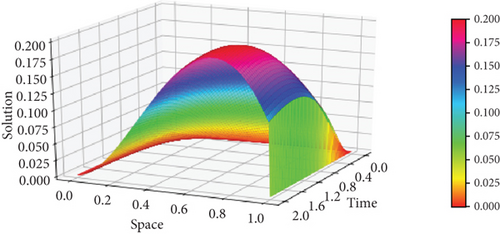
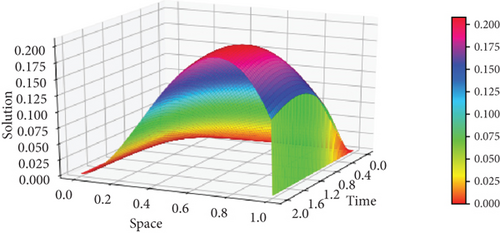


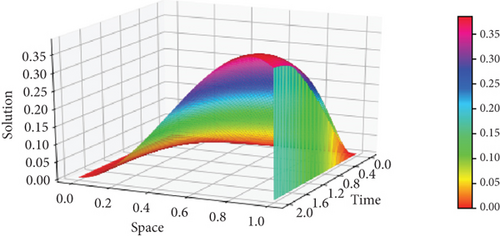
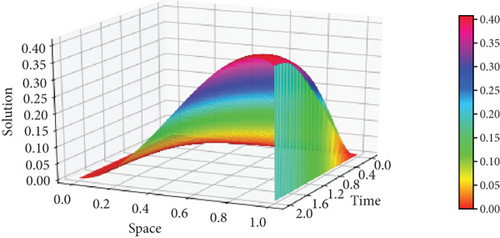

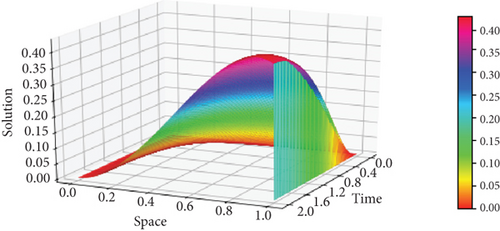
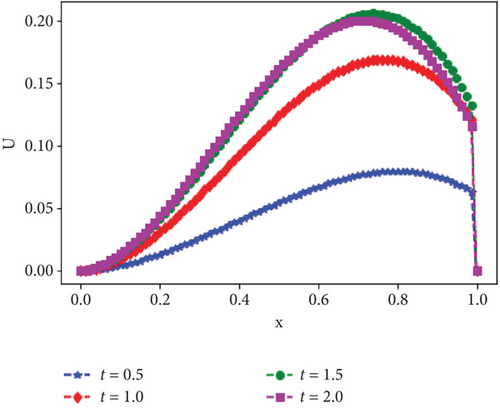


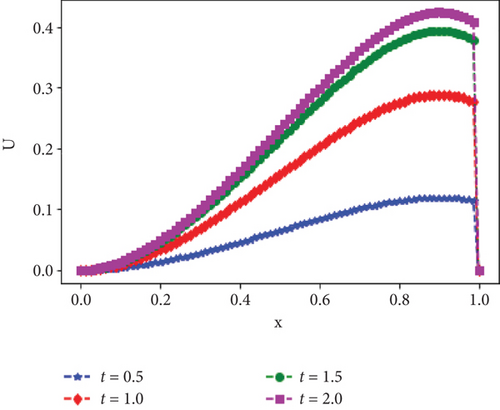
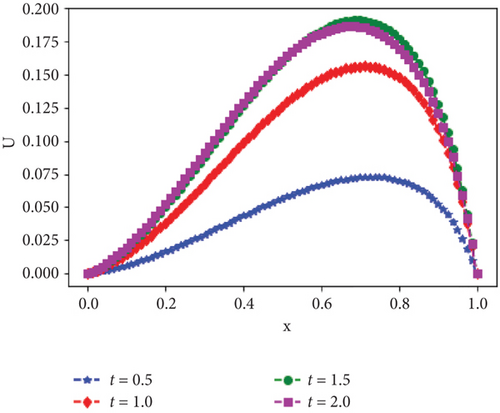

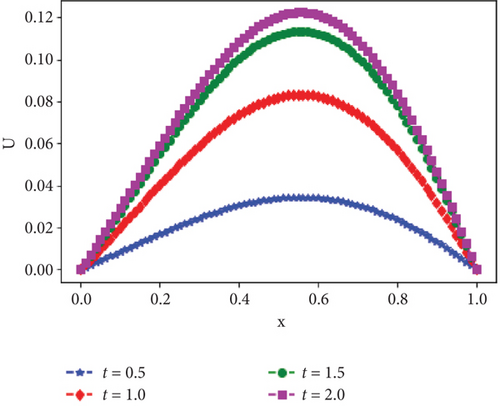
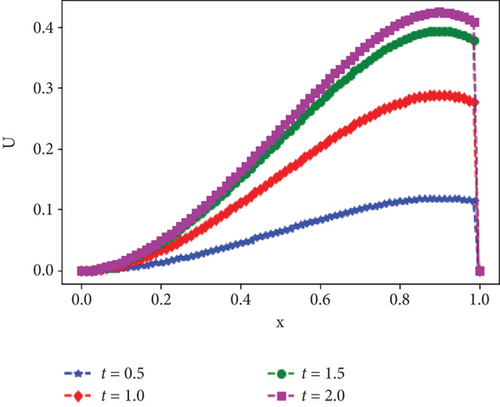
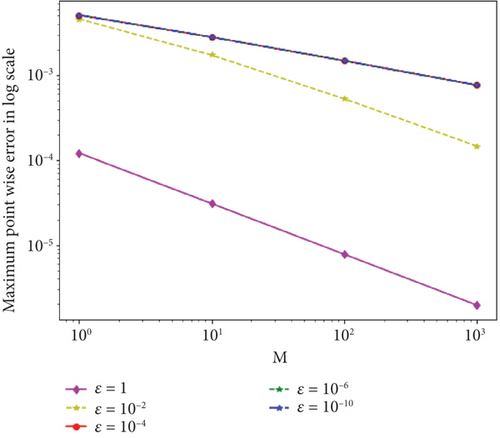
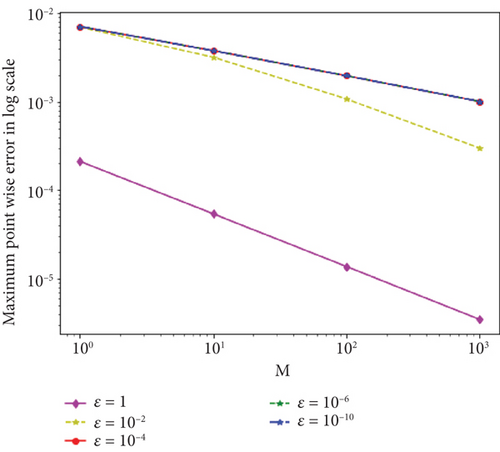
6. Conclusion
This article presents a parameter uniformly convergent numerical approach to solve one-dimensional time-fractional SPPDEs with large time delay exhibiting a regular right boundary layer. The domain is discretized with a uniform mesh in both time and space variables. The numerical scheme comprises the L1 scheme to approximate the time-fractional derivative and NSFDM together with simple upwind scheme to approximate the space derivatives. The stability and uniform convergence of the scheme is analyzed. It is shown that the proposed numerical scheme is parameter-uniform convergent and has a rate of convergence O((Δt)2−α + Δx). To validate the applicability of the proposed scheme, two test examples are presented and the numerical results support the theoretical predictions. The advantage of the proposed numerical method is that it is easy for implementation and it gives more accurate results. To demonstrate the efficiency of the proposed numerical scheme, comparisons have been made with the results of one pioneering work available in the literature.
In our future research, the authors will further develop a higher-order uniformly convergent numerical scheme to solve time-fractional SPPDEs with time delay that improves the accuracy of the proposed numerical scheme in this article.
Conflicts of Interest
The authors declare no conflicts of interest.
Funding
The authors received no specific funding for this work.
Acknowledgments
The authors are very grateful to the reviewers for carefully reading the manuscript and for their comments and suggestions that have improved the paper very much.
Open Research
Data Availability Statement
Data are contained within the article.



